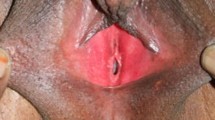Abstract
Female patients with congenital adrenal hyperplasia (CAH) may develop masculinized genitalia in utero upon exposure to excess androgen. This masculinization may be characterized by hyperpigmented or fused labioscrotal tissue, enlarged labia majora, a urogenital sinus, and clitoromegaly. Clitoromegaly may vary, ranging from an ordinary clitoris to a significantly enlarged clitoris similar to a near-normal penis, with any degree of intermediate variation. Surgical management of clitoromegaly may ensure adequate sexual function, promote consistent female gender identity development, and provide a typical clitoris aesthetic. Patients and families considering clitoral surgery should make every effort to understand the options, risks, and benefits of this surgery. If surgery is being considered, it should only be performed in centers with significant experience.
Access provided by Autonomous University of Puebla. Download conference paper PDF
Similar content being viewed by others
Keywords
These keywords were added by machine and not by the authors. This process is experimental and the keywords may be updated as the learning algorithm improves.
Female patients with congenital adrenal hyperplasia (CAH) may develop masculinized genitalia in utero upon exposure to excess androgen. This masculinization may be characterized by hyperpigmented or fused labioscrotal tissue, enlarged labia majora, a urogenital sinus, and clitoromegaly. Clitoromegaly may vary, ranging from an ordinary clitoris to a significantly enlarged clitoris similar to a near-normal penis, with any degree of intermediate variation. Surgical management of clitoromegaly may ensure adequate sexual function, promote consistent female gender identity development, and provide a typical clitoris aesthetic. Patients and families considering clitoral surgery should make every effort to understand the options, risks, and benefits of this surgery. If surgery is being considered, it should only be performed in centers with significant experience.
Reduction clitoroplasty is the most widely accepted and practiced surgical approach for clitoromegaly and maximizes clitoral aesthetic while preserving sexual function through neurovascular conservation. Specific surgical techniques vary with respect to the extent of glanular and corporal preservation as well as incision location. Consequently, outcomes are difficult to quantify objectively secondary to unsystematic record keeping and lack of large patient populations who have a consistent surgical procedure. Further, reservations about surgical intervention exist, centered on inconsistent or outdated surgical protocols, fears of nerve destruction or sexual dysfunction, a lack of histological data as a benchmark of surgical success, and little consistent clinical follow-up regarding sensation and function.
In an effort to maximize postoperative somatosensory function, the reduction clitoroplasty was modified in consideration of the dorsal nerves of the clitoris. The anatomic location of these important nerves has only recently been delineated in great anatomical detail. Briefly, the dorsal nerves course dorsally along the clitoral erectile bodies; they are most prominent at the 11 and 1 o’clock positions and send branches around the tunica until the 5 and 7 o’clock positions, between which nerves are absent.
The dorsal nerves serve several vital functions. They are the primary provider of somatosensory innervation to the clitoral body and glans. Dorsal nerve stimulation causes the cavernous nerve to initiate and maintain engorgement. Finally, the dorsal nerves carry nNOS-positive fibers, which may be efferents for clitoral engorgement. Both the somatosensory and erectile capacities are essential for normal female sexual function.
Beginning in 1996, our team has focused on providing the most specific surgical approach for performing reduction clitoroplasty. We have assessed the outcome of a modified ventral approach reduction clitoroplasty by analyzing hypertrophic erectile tissue obtained from patients undergoing this procedure. The erectile tissue has been examined for the presence and size of nerves from patients undergoing this procedure. Specific attention was paid to the circumferential nervous tissue, reflecting the course of the dorsal nerves. We have determined that no large nerve fibers remain with the excised erectile tissue indicating that they are left intact within the patient. Additional studies by our group have also confirmed that clitoral viability with respect to tissue perfusion and lack of ischemia is excellent. Furthermore, in a limited number of patients, clitoral sensation was evaluated and was determined to be intact to both touch and vibration.
Dorsal nerve preservation via a modified ventral approach reduction clitoroplasty may maximally preserve sexual function. Postoperative histologic and clinical data provide evidence that this modified ventral approach conserves dorsal nerve fibers and functions within these patients. The ventral approach reduction clitoroplasty described in this report leaves the dorsal neurovascular bundles of the corporeal bodies and the glans clitoridis intact. This is a safe and reliable approach for patients and families who are considering clitoral surgery. Sexual and social function of our patient cohort is difficult to assess until all patients reach sexual maturity. Continued, long-term follow-up is ongoing to document sexual function using this approach for patients following clitoroplasty.
Author information
Authors and Affiliations
Corresponding author
Editor information
Editors and Affiliations
Rights and permissions
Copyright information
© 2011 Springer Science+Business Media, LLC
About this paper
Cite this paper
Poppas, D.P. (2011). Clitoroplasty in Congenital Adrenal Hyperplasia: Description of Technique. In: New, M., Simpson, J. (eds) Hormonal and Genetic Basis of Sexual Differentiation Disorders and Hot Topics in Endocrinology: Proceedings of the 2nd World Conference. Advances in Experimental Medicine and Biology, vol 707. Springer, New York, NY. https://doi.org/10.1007/978-1-4419-8002-1_11
Download citation
DOI: https://doi.org/10.1007/978-1-4419-8002-1_11
Published:
Publisher Name: Springer, New York, NY
Print ISBN: 978-1-4419-8001-4
Online ISBN: 978-1-4419-8002-1
eBook Packages: Biomedical and Life SciencesBiomedical and Life Sciences (R0)




